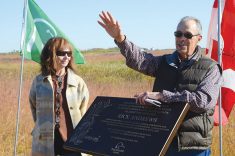Cow cams may promise peace of mind but, like most things connected to data agriculture, they also bring up the perennial challenges with rural internet.
Rural internet is an obstacle for the farmers wanting to adopt cow cams, Colin Palmer (a producer and speaker on cattle surveillance systems) admits. He has reaped the benefit of cameras in his own calving pen, but he also has the advantage of fast internet at his job at the University of Saskatchewan and his land sits close to Saskatoon and the “bubble” of urban-level internet service, an advantage unavailable to more remote farmers.
Even so, Palmer has still run into service issues. The addition of cameras was a drain on his family’s service package, and they eventually changed their service for quicker connection speeds and no data limits.

“We used to have trouble… we’d burn up all of our available data for that month pretty quickly, and so now we have unlimited data,” he said. “Especially when we were using the camera away from home, so we’re in Saskatoon, or we were out at a restaurant, or we were at work or whatever and we’d check, my wife would say ‘don’t leave the camera on,’ because it burns up data. Now, actually, with one monitor at my desk, I can leave it on.”
A different remote system at MBFI north of Brandon does not require cell service or outside internet to transmit to its main hub a mile away, Manitoba Agriculture livestock specialist Ray Bittner said, although that main connection must be line of sight. Bittner says a more extensive version could reach up to 15 kilometres.
Read Also

Your best (and easiest) holiday dainty tray
Make-ahead recipes, store-bought goodies and co-operation with friends and family: Here’s how to throw together a stunning, low-stress tray.
“You may need very tall towers,” he said. “Or, if you’re crossing a valley, you may need no towers. It depends. It’s line of sight.”
Manitoba’s spotty cell and internet service might be an issue, however, for anyone wanting to stream MBFI’s video to their phone. That would require both good cell and internet service in conjunction, Bittner said.
“Typically, when you’re in Winnipeg or Brandon or major towns, you’ve got a good cell connection, but it depends on your internet connection from your home, from your network video recorder to the internet,” Bittner said.
Mathew Kulbacki of Kulbacki Ag Supply says he has connected systems similar to MBFI on all current rural internet providers in Manitoba.
“Some work better than others,” he said.
Most connection problems are based on cell service rather than internet, he added.
“In marginal cell service, no, you can’t do it,” he said. “In Wi-Fi or something like that, it’s as good as sitting at home with your connection.”
















